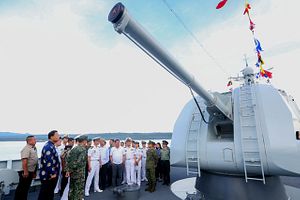Last week, after a four year hiatus, China and the Philippines resumed an annual defense and security consultation initially set up to take stock of and advance ties in this realm. Though it is still early days, the move was nonetheless notable within the context of the steady development of nascent defense ties between the two sides under Philippine President Rodrigo Duterte despite the challenges that remain.
As I have noted before, though many today tend to focus squarely or overwhelmingly on the defense ties between the Philippines and the United States and consider Duterte to be a stark departure from Manila’s past behavior, past Philippine leaders have also maintained close ties with other actors as well in this realm in recent years to varying degrees, including China (See: “The Limits of Duterte’s US-China Rebalance”).
To be sure, during the Cold War, as was the pattern with other non-communist Southeast Asian states, the Philippines and communist China were on opposite sides of the broader struggle, and Beijing’s links to insurgent movements in the subregion further sowed distrust. Indeed, even after the formal establishment of diplomatic ties in 1970s and then the end of the Cold War in 1991, defense links remained almost non-existent for the most part apart from a few visits and occasional consultations.
Even where such interactions were started, whether it be the establishment of armed forces attaches between the two sides or consultations on challenges in the relationship such as the South China Sea disputes, flashpoints like the 1995 Mischief Reef Incident did not help as they only reinforced Manila’s long-held suspicions of Beijing.
Yet particularly in the 2000s, under former Philippine President Gloria Macapagal Arroyo, there was a concerted effort by both sides to develop defense ties as part of the broader relationship. That led to a noticeable uptick in military relations in metrics such as exchanges, exercises and other interactions, along with a few notable firsts such as the first official visit of Philippine naval vessels to Beijing.
Among these notable developments during the early 2000s had been the inking of a memorandum of understanding (MOU) on defense cooperation between the two countries in November 2004. Under the MOU, both sides had agreed to focus their cooperation on the exchange of military delegations, the discussion of non-traditional security threats such as counterterrorism and humanitarian assistance and disaster relief, and the establishment of a regular defense mechanism, which was originally called the Philippines-China Annual Defense Security Talks (ADST).
Per the original MOU, the ADST, which was to be held at the level of undersecretary or vice-defense minister, were to be held annually, comprising of a delegation of around five people and with the venue alternating between the two countries. As is typical of such mechanisms for consultation here was also a joint technical working group (TWG) envisaged that would help with the preparation for talks and monitor its progression.
Yet in practice, after four iterations of the supposedly annual forum were held between the two sides since 2005 – with the last one being in Beijing in 2013 during the presidency of Benigno Aquino III – the ADST had not been held. This was part of a broader trend where an initially warm opening for Sino-Philippine ties during the Aquino era were soon dashed, most prominently by China’s assertiveness in the South China Sea as clearly manifested during the Scarborough Shoal flashpoint (See: “The Danger of China-Philippines South China Sea Joint Development”).
As I have written repeatedly in these pages, following Aquino’s pursuit of closer ties with the United States and a high point for the U.S.-Philippine alliance, Duterte’s initial pursuit of a so-called ‘independent foreign policy’ – read to mean diversifying Philippine alignments to include not just traditional allies and partners like the United States but also newer partners like China and Russia – has opened up room for the advancement of Sino-Philippine defense relations, even though that also has not foreclosed the possibility of stronger ties with Washington (See: “What Will US-Philippines Military Exercises Look Like in 2018?”).
Though progress has been slower than the headlines might suggest, we have also admittedly seen forms of cooperation that were previously unthinkable just a few years ago, from deliveries of military equipment to closer coast guard cooperation and even law enforcement assistance. China has also looked to make further inroads in areas like maritime security, intelligence-sharing, and counterterrorism exercises. Though collaboration has so far been quite rudimentary, officials have hinted that incremental progress can be expected in 2018 in areas like visits, exchanges, assistance, and perhaps even basic training.
On December 15, both sides finally held the fifth iteration of the ADST. The Philippine delegation was led by Undersecretary for Defense Policy Ricardo A. David Jr., and the Chinese side was led by Rear Admiral Jiang Guoping who is the assistant chief of general staff of China’s Joint Staff Department of the Central Military Commission.
The talks covered both issues within the bilateral relationship as well as regional security issues. Philippine defense spokesperson Arsenio Andolong said that the two sides had discussed non-traditional security challenges like terrorism and natural disasters – as the original MOU had specified – and had also agreed to increase cooperation in areas like training and education. The talks also touched on the South China Sea, where, as I have noted, concern still persists about China’s assertive behavior despite the adoption of the so-called framework for the code of conduct (COC) in the South China Sea and Beijing’s agreement to pursue a binding COC (See: “Will a China-ASEAN South China Sea Code of Conduct Really Matter?”).
As with other Sino-Philippine defense consultations we have seen of late in the Duterte era, few specifics were disclosed about what exactly we might expect. But the revival of the ADST is yet another sign of a broader trend of increased collaboration with both sides on the security side for now despite a mutual acknowledgment of the challenges that remain.

































